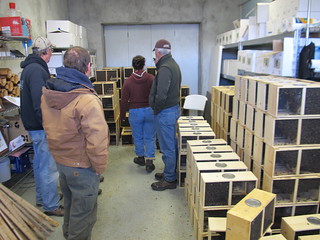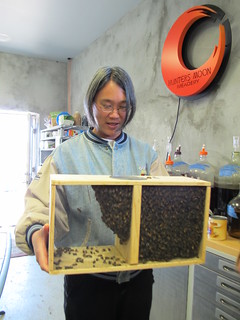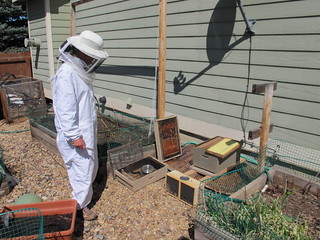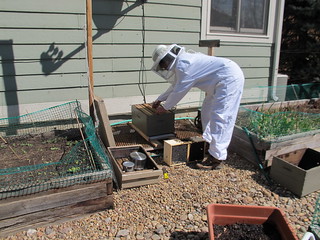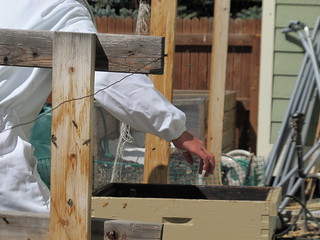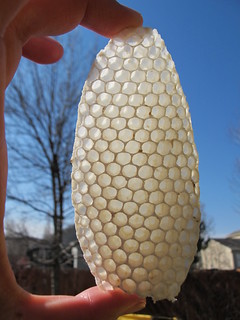Several years ago I took the Boulder County Beekeepers' Association class for how to keep bees. It was in the Boulder County Farming co-op and it was in the dead of winter. They told us all about the thousand ways bee colonies can be killed and how to do your best to slow down the death... So I didn't really seriously think about it for quite some time. Last year, one of the big Denver pollination and honey outfits died, and they were selling their equipment for cheap, and I got six boxes, a feeder, a queen excluder, and a telescoping top for $100... Yes, the class told me everything about why getting used equipment was a bad idea, but... it was so inexpensive, and I just wanted to try. Succeeding wasn't so much the point, as just actually having the courage to try.
There's a long story about a swarm that ended up in a chimney that escaped my boxes, but it ended up with me wanting to order a package of bees this spring. I made a mistake, doing to the BCBA's forum pages, and instead of buying a package from Tom and Miles, I accidentally bought a package of Minnesota Hygenics from the Northern Colorado Beekeepers' Association. *laughs* Which delivered their beauties on Tuesday, in the midst of snow, and with a night in the low 20's to come.
We'd been having snow pretty much every week, nearly a foot of it for each of the last three storms, so this was a portion of our 'front yard' when we pulled out of the driveway. The good thing was that the streets and sidewalks had cleared and dried, eventhough it had snowed all morning! It was pretty cold, and the drive out to Severance is nearly a full hour out. John was kind enough to do the driving, and let me worry in the passenger seat.
Even before ordering these bees there were rumors that many of the queen rearing companies were having difficulties filling full orders of three pounds of worker bees to go with their queens. And I was recalling all the twenty thousand ways it seemed that one could kill off ones bees! *laughs* The Northern Colorado Beekeepers' Association was assured that their California Supplier was capable of doing the full packages, no problem and they were right.
They were allowing people to pick up packages from about 7 am, and this is what was left by a bit after noon. They'd started with over 460 boxes, or somewhere between five to six million bees!!
Each of the "packages" is that wooden box, there's a can of sugar syrup in there hanging down, and there's small holes poked through the bottom so that the bees can feed from them. The small metal tab to the left of each of the cans is connected to the queen's cage, which hangs in the midst of the ball of worker bees.
They take care of her, feed her, keep her cool, and ball around her to protect her while they're without a home. The box makes it really easy to hold them, no protection necessary, and it's an amazing thing to just stand there and hold ten thousand bees at once, hearing them hum.
One of the amazing things was that there were hundreds of 'free' bees hanging out in the garage, just hanging from some of the garage door windows, and people were joking about those being the ones I'd bought and that I could just gather them up and keep them. But they were just hanging out with the beekeepers.
Watching some of the videos of people keeping bees, it always seemed like magic that they could go out there and do what they do with minimal protection and maybe just a veil. Going into a cloud of bees seemed to incredibly crazy, there's this visceral reaction to that sound of insects buzzing. But it was amazing, with the cage, to see that there were five workers who had clung to the outside of the cage and just stayed there. Even when I picked it up and walked around with it and stuck it in the truck of our car, they just stuck with their sisters. No problem. I tried blowing them off, and all of the bees started to hum at a higher pitch. So I just left them.
We took them home and since it was going to be in the lower twenties that night, we kept them in our basement to stay warm. There was still plenty of syrup, so I let them just be, and when they were in the darkness of the basement after the sun went down, they went utterly quiet. I'm starting to realize what "domesticated" means with these creatures. I had to keep them in the house the next day, too, as the next night was going to be freezing as well, but not quite as bad, and Thursday was going to be really warm, so it would be easy to install them then, and the next four days and nights were promising to be really nice.
But I fretted for most of the day as it felt like the syrup can had been emptied and I was supposed to spray sugar syrup on them, but didn't have a great idea as to how often and then what were they going to do about water? *laughs* I worried a lot, but John and Jet put up with me.
One of the intriguing things was realizing that honeybees have a unique smell to them. It's sweet, heavy, a little musky, almost like how "golden" should smell. It was most noticeable in the garage with all those bees, but after the ladies had stayed in a small room in the basement for a while, it was easy to distinguish from other scents.
Then lots of stuff happened to land on Thursday. I was signed up for and had a lot of fun fun working a stint at the church rummage sale. I got called to meet with the publicity director for Longmont Safety in order to interview for a 4 hours a week volunteer position with their 911 group, and I realized I had a dentist appointment, too. So between the rummage sale and the interview, I decided to install the bees!
It was beautiful and sunny out and nearly all the snow had melted, so I went out with all my equipment and got to work.
John primed me with a YouTube video with a keeper who did the whole installation without any protective equipment whatsoever, but I really wanted to use the suit and veil since I had them. I figured if I was more confident, it wouldn't hurt and I'd still be able to move carefully. I did, however, consciously decide not to use any gloves. I didn't want to fumble the queen, and was ready to risk a few stings for the control I wanted to have.
It turned out to be a good choice, and it was kind of amazing how easy it was. The video will give you a sense of what it was like, live, as they were buzzing pretty good in the warm sunshine on the gravel in front of the hive. I jiggled out the syrup can and then the air was filled with bees!
Here's the box with the can out, and bees were everywhere. It's one thing to be told that it's all right, and that they aren't just going to attack you. It's a whole other thing to be standing feeling the wind of their passage, hearing the heavier, louder, higher pitched buzz now that they were out, and fighting that instinct so that I could move smoothly and slowly. But they were moving like they were just exploring, figuring out where they were, what they were going to do. It was pretty heady stuff to have them everywhere and realize that it was very much doable for me to work calmly right there and do the right thing.
With the tab as far along the slot as it was with these boxes, there was no chance that I was going to drop the queen into the mass of bees the way he did. I gently lifted the tab, worked it along the slot, and got her and her cage out with no problems. There was a mass of attendants around her, and I gently shook them off so that I could see her. She was fine. Alive, looking around, and touching the mesh. There was mesh on just one side of her box, so I turned that toward the open space between frames, and rubber-banded the box in so she'd stay near the top, and gently put the frame back into the box.
There were a good number of bees already in among the frames. Since there was beeswax on all the bases, they were already feeling at home in there, so I just tipped the box they came in on its side over the frames, and set another empty deep around the cage.
The opening for the cage was a little close to one of the walls, so I reached in with bare hands and moved the cage over. They were crawling everywhere and humming. One bee made it inside my veil at this point and was buzzing in my ear. *laughs* I ignored her, and just moved the cage so that the opening had more room.
There were hundreds of bees still behind the mesh buzzing away and disorganized now that a bunch of them had gotten out. While they'd been waiting in the basement, they'd hung onto each other around the can and the queen cage. With both of those gone, they were a little upset and looking for a way out.
The beauty of putting the cage in on top of the frames was that I didn't have to shake them all out. It's a gentler way of letting them get out on their own. I put all the sugar syrup I had into the feeder, and put it on top of the top deep, and then added the telescoping lid. The feeder has an opening directly to the rest of the hive, and with the lid other bees and wasps can't get at the syrup.
The amazing thing to me was that the bee in my bonnet never stung me, and when I finally let her go, out of the veil, she hung around me for a little while longer, as if to check me out and then finally flew off. The adrenaline rush was pretty amazing, when I finally got to sit down and shake a little. *laughs*
John was pretty impressed with the whole thing, and enjoyed taking his pictures, and realizing that he could walk into the cloud of bees and not even get touched if he moved slowly enough.
After all that, I aced the interview with the police department. The lady doing the gating pretty much talked with me for ten minutes and decided that I'd be perfect for what they needed. Most of their volunteers are a little too afraid of the computers, and this was a lovely station with five screens and more machines underneath than I had the time to count. I also got to meet the head of the department and shake her hand and that was pretty much good enough, it seemed. It's a pretty simple job, but one that requires time and concentration, and just half a day about once a week. So it should be pretty straightforward to do.
I actually fell asleep doing the teeth cleaning. I didn't get much the last couple of nights, especially with the anxiety over feeding them. So... uhm.. yeah. Jet also wanted sweet potato noodles for dinner, so as soon as I was home, I was roasting sweet potatoes and the three of us made noodles that night. Enough to eat and then the rest of the dough to dry for our own sweet potato pasta.
It costs eight dollars a pound at Pappardelle's, and this morning we stored a pound, dry, after eating half again as much the night before. It probably cost us a little more than a dollar to make, and when I cooked the sweet potatoes, I accidentally left the center a little firmer than fully cooked, and grated the insides with a box grater to skin them easily (the skins don't like going through the grater). So there were small pieces of sweet potato in the pasta. The wonderful thing about that was that it really intensified the flavor in the noodles!
This morning when the sun was up but hadn't gotten to the garden, yet, over the trees, I went out to water the garden and none of the bees were out. They were quiet and completely docile. John even opened the top to take a look to see if they needed more syrup, and it was completely empty.
While they were that quiet we decided to just lift the lid and pull out the traveling box. There was one big ball of bees on one side between the wall and the box. They'd started to dot the whole box with wax, and inside the box all there were were the bees that had died traveling and one leaf of fresh bees wax. This one. It was gorgeous and so very light. But as you can see in this picture, the sunlight went right through it and you can see the intersections of the walls so that each cell most strongly supports the other, front and back as well as side to side.
The piece was surprisingly strong. Since the feeder was completely empty, I cooked up more sugar syrup and after it had cooled enough, went out to put it in. The sun had gotten much higher and it was much warmer and the bees were out in force.
I was a little frightened to open the thing up. But I told myself I was a wuss, and just barehanded and headed, I got up the telescoping lid, and poured the syrup into the feeder. A few of the bees were underneath the raft, cleaning up the last of the sticky syrup of the day before, and they rolled out with the flood of syrup, grabbed the wood of the raft and pulled themselves out. Other workers rushed over to help clean them off, and it was kind of funny and amazing, too.
All of them were pretty agitated and even more so when I tried to brush a few off the edges so that I could put the lid back on. I really should just find one of those windshield brushes to gently brush them off with that instead of trying to use the hive tool to take them off. The hard tool crunched one a little, and the whole cloud suddenly started buzzing at a much higher pitch. It took a gut check to keep going, but I really wanted to get the lid back on, and it took a few tries before it was on straight and I didn't think I was crushing any MORE workers.
So I just stood there, in the midst of zinging bees that were bouncing off of my sweater, and just swallowed the fear and did it. Again, none of them stung me, and I was forcibly reminded that these are domesticated bees. Still... I think that I'm going to put more syrup in tonight, after it's dark, when they're all in their sleeping ball and out of the feeder, instead of doing it mid-day again.
And when I actually free the queen from her cage, it's going to be in full gear. Probably no gloves again, just 'cause I really don't want to crush her and I'm going to have to use something to get that cork out. The two or three days are so that they can get used to her and so that they know that this is home and their hive. So I think it'll be fireworks one more time, I can put another brood box over the one that's there, and then I can leave them for another five days to a week before checking to see if the queen's laying and doing her thing.
Afterward, John checked the internets and figured that we have about ten thousand bees out there. Three pounds of bees is anywhere from ten thousand to twelve thousand workers. That's a LOT of bees. I think that they all made me very very present in the time I was there. *laughs* If anyone ever needs a method of meditation that stops all wandering thoughts, I'd suggest going out to visit the bee box with no protection whatsoever.
Friday, April 26, 2013
Friday, April 19, 2013
Starting a Beekeeping Blog...
I've decided to start a beekeeping blog, mostly because I've been blogging since 1997 and beekeepers really do try to keep track of what they do and when they do it in order to know what happened before in order to make informed decisions about what to do in the future. I figured I might as well take advantage of technology that I'm well familiar with and do what I have to do anyway. I'll probably be posting links from this blog to my G++ and other social media.
I have one good friend who's now into beekeeping, and I loved what he said, in the days before I got my first package: "These are like any other girls. Treat them nice, and they're very sweet. Abuse them, and they turn vicious. Abuse just one, and she tells her friends to attack." -- Kenneth Adelman
I intend to inspect the hive on a regular basis, and actually manage and husband my little ladies instead of just letting them go their merry way and not do the maintenance and upkeep and I am likely to have to deal with mites and other problems along the way.
I am starting this hive mainly because I've watched the decline in numbers of the Boulder County Beekeepers' Association, and in the numbers of the hives and swarms being reported here on a regular basis, it's been depressing, and I wanted to do something and finally got the time and energy back to do it. So... here it is...
And I'll try to do less justification and more actual hands-on blogging about what I'm doing and how I'm doing it and the consequences thereby. Thanks.
I have one good friend who's now into beekeeping, and I loved what he said, in the days before I got my first package: "These are like any other girls. Treat them nice, and they're very sweet. Abuse them, and they turn vicious. Abuse just one, and she tells her friends to attack." -- Kenneth Adelman
I intend to inspect the hive on a regular basis, and actually manage and husband my little ladies instead of just letting them go their merry way and not do the maintenance and upkeep and I am likely to have to deal with mites and other problems along the way.
I am starting this hive mainly because I've watched the decline in numbers of the Boulder County Beekeepers' Association, and in the numbers of the hives and swarms being reported here on a regular basis, it's been depressing, and I wanted to do something and finally got the time and energy back to do it. So... here it is...
And I'll try to do less justification and more actual hands-on blogging about what I'm doing and how I'm doing it and the consequences thereby. Thanks.
Subscribe to:
Posts (Atom)

